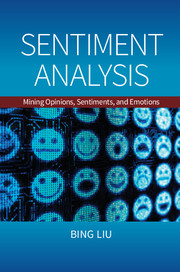Book contents
- Frontmatter
- Contents
- Preface
- Acknowledgments
- 1 Introduction
- 2 The Problem of Sentiment Analysis
- 3 Document Sentiment Classification
- 4 Sentence Subjectivity and Sentiment Classification
- 5 Aspect Sentiment Classification
- 6 Aspect and Entity Extraction
- 7 Sentiment Lexicon Generation
- 8 Analysis of Comparative Opinions
- 9 Opinion Summarization and Search
- 10 Analysis of Debates and Comments
- 11 Mining Intentions
- 12 Detecting Fake or Deceptive Opinions
- 13 Quality of Reviews
- 14 Conclusions
- Appendix
- Bibliography
- Index
3 - Document Sentiment Classification
Published online by Cambridge University Press: 05 June 2015
- Frontmatter
- Contents
- Preface
- Acknowledgments
- 1 Introduction
- 2 The Problem of Sentiment Analysis
- 3 Document Sentiment Classification
- 4 Sentence Subjectivity and Sentiment Classification
- 5 Aspect Sentiment Classification
- 6 Aspect and Entity Extraction
- 7 Sentiment Lexicon Generation
- 8 Analysis of Comparative Opinions
- 9 Opinion Summarization and Search
- 10 Analysis of Debates and Comments
- 11 Mining Intentions
- 12 Detecting Fake or Deceptive Opinions
- 13 Quality of Reviews
- 14 Conclusions
- Appendix
- Bibliography
- Index
Summary
Starting from this chapter, we discuss the main research topics of sentiment analysis and their state-of-the-art algorithms. Document sentiment classification (or document-level sentiment analysis) is perhaps the most extensively studied topic in the field of sentiment analysis especially in its early days (see surveys by Pang and Lee, 2008; Liu, 2012). It aims to classify an opinion document (e.g., a product review) as expressing a positive or a negative opinion (or sentiment), which are called sentiment orientations or polarities. The task is referred to as document-level analysis because it considers each document as a whole and does not study entities or aspects inside the document or determine sentiments expressed about them. Arguably, this is the task that popularized sentiment analysis research. Its limitations also motivated the fine-grained task of aspect-based sentiment analysis (Hu and Liu, 2004) (Chapters 5 and 6) that is widely used in practice today.
Document sentiment classification is considered the simplest sentiment analysis task because it treats sentiment classification as a traditional text classification problem with sentiment orientations or polarities as the classes. Thus, any supervised learning algorithms can be applied directly to solve the problem. In most cases, the features used in classification are the same as those used in traditional text classification too. Owing to its simple problem definition and equivalence to text classification, it has served as the base task of several other research directions adapted from the general text classification, for example, cross-lingual and cross-domain sentiment classification.
To ensure that the task is meaningful in practice, existing literature on document sentiment classification makes the following implicit assumption (Liu, 2010).
Assumption 3.1: Document sentiment classification assumes that the opinion document d (e.g., a product review) expresses opinions on a single entity e and contains opinions from a single opinion holder h.
Thus, strictly speaking, document sentiment classification can only be applied to a special type of opinion documents. We make this assumption explicit in the task definition.
- Type
- Chapter
- Information
- Sentiment AnalysisMining Opinions, Sentiments, and Emotions, pp. 47 - 69Publisher: Cambridge University PressPrint publication year: 2015
- 1
- Cited by



